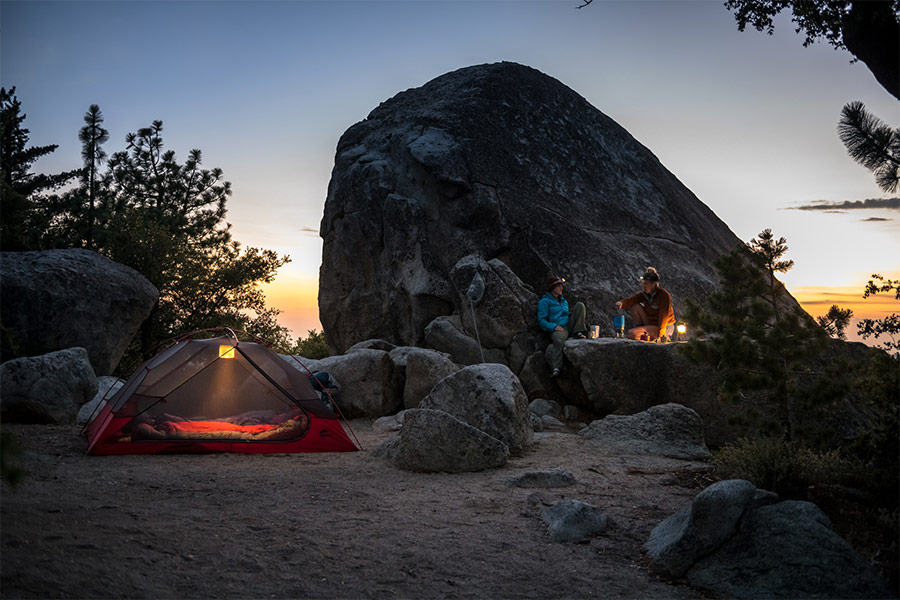Tent Camping Tips Begin With A Good Campfire
A list of suggestions for tent camping would be incomplete without a discussion of fire construction. Since Prometheus gave man access to fire, its properties have been prized throughout history. Its significance on a camping trip is comparable to that of a spiritual healer since it can boost morale and provide strength on a wet or cold day.
Consequently, building a fire can be accomplished in numerous ways. However, keep the following camping advice in mind.
01. Find an area with at least 6 yards of open space surrounding it. (Nearly all campsites should be able to accommodate this number of campers.) Additionally, it is prudent to avoid regions with several dead, overhanging branches. If it has recently rained or there is snow on the trees, cover the fire with a tarp. This is to prevent falling snow or rain from extinguishing the fire when the wind blows.
2. Size: Clear a 3-yard radius around the fire of surrounding undergrowth. This action is taken to avert a bush fire. If the campsite has been experiencing a drought or has been exceptionally dry, this radius should be increased to 5 yards.
03. Typically, fires are contained by creating a pit lined with pebbles or by using a backlog. A backlog is a huge log used to support the fire. These containment structures are utilized to contain the fire. For the majority of camping locations, any containment is acceptable. However, a pit walled with rocks is preferable in mountainous regions where strong winds might extinguish a fire.
04. Before making a fire, it is a good idea to have your fuel prepared. This prevents you from having to search for firewood during the earliest stages of building a fire. There are three varieties of firewood that must be prepared.
a. Shavings or tender: These are the strips your knife cuts from the deadwood. Grass and cotton can also be utilized as tenders.
Kindling is comprised of twigs and pine needles. These can be extracted from dead trees and burn for a longer duration than shavings.
c. Various sizes of deadwood: These should be added to the fire in order of increasing size until the desired size of the fire is achieved.
05.I recommend building a tiny teepee out of the shavings and lighting them to start a fire. As the fire begins to burn, you should add kindling and then dead wood of various sizes.
a. With one exception, if the deadwood is moist, split it with an ax. The interior wood is typically drier, allowing it to burn more easily.
06. This is typically determined by your camping spot, but it is still a good idea to know your forests.
a. Softwoods such as pine, fir, and cedar are ideal for shavings since they burn quickly. However, they emit little heat and have a short lifespan. Additionally, cedar and pine can become extremely smokey and should be avoided when cooking.
b. Medium-density hardwoods, such as maple, aspen, and cottonwood, burn a little longer and make excellent kindling.
c. Hardwoods, like oak, generate the most heat and burn the longest. Therefore, they are ideal for cooking.
07. Firewood Supply: There is never enough firewood. Once the fire is established, make occasional trips for more wood. Always purchase more than you believe you will need.
8. Dry Wood: For morning fires, it is advisable to bring dry wood into the tent the night before. This will aid in preventing dew or rain from falling during the night, which would delay the initiation of the morning fire.
09. Other Tent Camping Fire Building Tips:
A a. You can utilize live wood to set up your cooking area. Live wood is less prone to catch fire and can thus be used to create pot hooks to hold pots, frying pan stakes, and even an overhang for the fire by slicing two Y-shaped pieces and placing a straight crosspiece over the notches of the Y-shaped pieces.
b. Morning coals: If the weather permits, it is advisable to build a large evening fire with hardwoods. Frequently, you will still have coals that can be utilized to start the fire in the morning.

Comments
Post a Comment